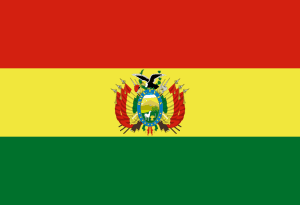
| Colors | HEX Code | RGB | CMYK |
|---|---|---|---|
| Red | #CF2011 | 207, 32, 17 | 0, 85, 92, 19 |
| Yellow | #F0E73C | 240, 231, 60 | 0, 4, 75, 6 |
| Green | #00712C | 0, 113, 44 | 100, 0, 61, 56 |
The Bolivian flag is made of three horizontal stripes of equal width. The colors of the flag are red, yellow, and green from top to bottom. The official flag has a coat of arms depicted in the middle of the flag on the yellow stripe. The coat of arms represents a circle with Mount Potosi and an alpaca standing next to a tree and wheat. Behind the circle, there are two crossed cannons, an axe and Phrygian, and ten stars. Two branches surround the circle and an Andean condor, a South American bird, is on top. The flag is used with or without the coat of arms.
Meaning of the Bolivian flag
The red color in the Bolivian flag represents the brave army that fought for the country’s independence.. The yellow color stands for the mineral wealth of the country. The green color represents the beautiful green forests and nature of Bolivia. The three colors were also widely used by the Native people who wore these colors before the arrival of the Spanish army. The coat of arms represents the Bolivian mountain which was a rich mining site in South America. The wheat stands for abundance. The two cannons represent the army’s power, while the axe is a symbol of freedom. The ten stars symbolize the Bolivian states, the branches are for peace, and the bird represents nature.
History of the Bolivian flag
Bolivia was a Spanish colony until 1825. The flag has changed several times. The original flag was made of red and green stripes with a yellow star on the red stripe, surrounded by a green wreath. The flag was changed in 1852, becoming a tricolor flag with the coat of arms in the middle. Later, in 1851, the current flag was officially adopted in 1951. Since 2019, Bolivia has also adopted a colorful flag to represent the indigenous people. It is considered the second official Bolivian flag.